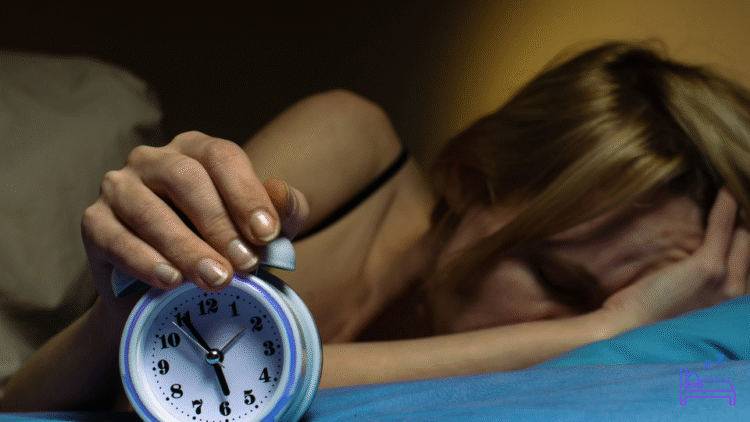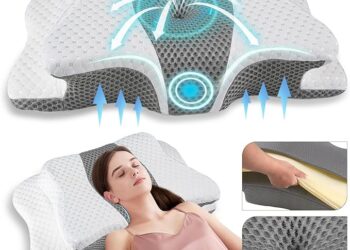Waking up with a stiff, sore neck is one of life’s small but stubborn miseries. Whether your neck pain began after a long day at a desk, a bad night’s sleep, or it’s become a chronic companion, small changes to how you prepare for bed, the way you sleep, and the tools you use can make a huge difference. This guide pulls together the latest research (2023–2025), NHS guidance, and practical tips so you can get better sleep and help your neck recover.
Quick takeaways (for people who want action now)
-
Sleep on your back or side — avoid stomach sleeping.
-
Use one supportive pillow that keeps your head aligned with your spine; avoid stacks of pillows.
-
Try gentle neck exercises and pain-education strategies during the day; they improve pain and sleep.
-
Consider ergonomic or contour pillows (trial to find what fits you) — recent studies show benefits for some people.
-
If pain is severe, getting worse, or accompanied by numbness/weakness, see your GP or NHS 111.
(You’ll find the evidence behind these points throughout the article.) nhs.uk+1
Why neck pain ruins sleep — and why improving sleep helps pain
Neck pain and poor sleep are tightly linked. Pain wakes you up, and poor sleep lowers your pain threshold and slows recovery — a vicious cycle. Modern research shows that interventions that combine education about pain with active exercise can reduce pain and improve function; better sleep often follows as people move more comfortably through the day. PMC
Get your sleeping position right
Position matters more than brand names.
-
Back sleeping (supine): Often the best for neck alignment. Use a medium-loft pillow that supports the natural curve of your neck so the head is neither pushed forward nor tilted back.
-
Side sleeping: Common and fine — pick a pillow thick enough to keep your head level with your spine so your neck isn’t bending downwards or up.
-
Avoid stomach sleeping: It forces your neck to twist and extends it unnaturally; this commonly aggravates neck pain. NHS advice recommends back or side positions and warns against face-down sleeping. nhs.uk
Practical tip: Lie on your bed in your chosen sleeping position and have someone check the side view — your neck should be a straight line with your spine.
The pillow debate: what the latest studies say
There’s a lot of pillow marketing — but what does the evidence say? Systematic reviews and recent trials suggest that pillow design (shape, height, fill) can influence neck pain, waking symptoms and sleep quality. Ergonomic, contour and adjustable pillows often help people by keeping the head and neck aligned.
When discussing finding the right pillow there isn’t a one-size-fits-all solution, the comfort you need is influenced by your sleeping style, body shape and whether you’re a side, back or stomach sleeper.
Well-known medical literature up to 2024 and ’25 showed that using the right pillow is a virtually risk-free way to alleviate neck pain and improve the quality of your sleep.
To get started, consider matching the loft of your pillow to your sleeping position.
- Higher lofts for side sleepers and lower ones for back sleepers.
-
Consider adjustable or water-base pillows (you can fine tune firmness/height).
-
Try before you buy where possible — many UK retailers offer trial periods.
-
Replace pillows every 1–3 years depending on wear.
Mattress matters (but less than the pillow)
A mattress that’s too soft can let the shoulders sink and twist the neck; too firm may increase pressure points. NHS guidance suggests a supportive mattress that keeps your spine neutral. If your mattress is very old or sagging, consider replacing it — but in most cases, pillow changes and habits have a faster effect on neck pain than a new mattress.
Source – nhs.uk
Bedtime routine: small habits that make a big difference
-
Wind down early: Aim for consistent sleep times. Chronic sleep disruption increases pain sensitivity.
-
Gentle neck mobility before bed: Slow, pain-free neck rolls (within comfortable range) and chin tucks can relax muscles. Avoid aggressive stretching just before sleep.
-
Heat therapy: A warm shower or a microwaveable wheat pack on the neck for 10–15 minutes can loosen muscles. Avoid intense heat that could disrupt sleep.
-
Reduce screen time an hour before bed. Blue light and mental stimulation can make it harder to fall and stay asleep, indirectly worsening pain.
-
Mind your evening posture: Sitting hunched over a laptop or phone increases neck load — sit tall, support your lower back, and avoid long static positions.

Exercises and education — the active part of recovery
Recent meta-analyses show that combining pain neuroscience education with tailored neck exercises reduces pain and disability more than passive treatments alone. Exercise helps restore mobility, improve muscle control, and reduce fear around movement — and better daytime function equals better sleep at night. Aim for a programme recommended by a physiotherapist, but simple daily routines include chin tucks, shoulder blade squeezes, and gentle range-of-motion exercises. PMC
If NHS physiotherapy waiting lists are long, many trusts offer self-help leaflets and online resources — use those to start.
Manual therapy and other clinic treatments — what helps sleep?
Hands-on treatment such as gentle mobilisation or manipulation from a trained physiotherapist or osteopath can reduce pain for some people. A 2025 review found cervical manual therapy often improved sleep quality in people with chronic neck pain, though effects can vary between individuals. These treatments are best combined with exercise and self-management rather than used alone. MDPI
If you try manual therapy:
-
Choose a registered practitioner (physio, osteopath or chiropractor) and discuss realistic goals.
-
Use it as part of a broader plan — home exercise, posture work, and sleep hygiene are critical.
When to see the GP or get urgent help
Neck pain is usually benign and resolves with conservative care. Seek immediate medical attention or call 111 if you have:
-
Numbness, tingling, or weakness in arms or hands.
-
New bladder or bowel problems.
-
Severe, worsening pain not helped by rest or medication.
-
Recent major trauma (e.g., a fall, car crash).
For ongoing pain that doesn’t improve, your GP can discuss imaging, refer to physiotherapy, or consider medications for short-term relief.

Products & practical buys (UK-friendly)
-
Contoured cervical pillows — widely available in the UK; check trial policies and return options. Recent reviews and tests highlight memory foam and adjustable water pillows as useful options for many. Source – Tom’s Guide+1
-
Heat packs — microwaveable wheat packs or electric low-setting heat pads for pre-bed relaxation.
-
Ergonomic workstation kit — if your neck pain is work-related, investing in a laptop riser and external keyboard helps posture during the day.
A simple 7-day plan to start sleeping better with neck pain
Day 1: Evaluate your sleeping position and pillow. Try sleeping on your back with one pillow.
Day 2: Begin gentle neck mobility (3× daily). Add a warm shower before bed.
Day 3: Swap to a supportive pillow (even if it’s temporary) that aligns your head.
Day 4: Practice 20 minutes of mindful breathing before bed to reduce anxiety and muscle tension.
Day 5: Add shoulder blade and chin-tuck exercises morning and evening.
Day 6: Reassess comfort — if you wake with pain, adjust pillow height.
Day 7: If little improvement, book a GP or physio appointment (or use NHS online self-referral resources).
Pain Relief Cervical Pillow for Neck Support, Adjustable Ergonomic Pillow On AMAZON

Buy Now – https://amzn.to/4ozDBYS

































Discussion about this post